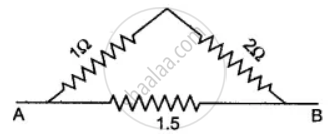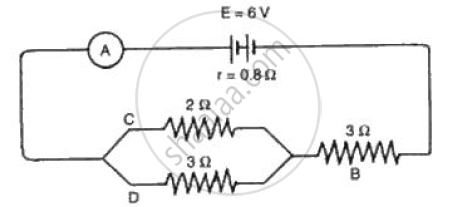Advertisements
Advertisements
प्रश्न
उत्तर
APPEARS IN
संबंधित प्रश्न
One coulomb charge is equivalent to the charge contained in:
(a) 2.6 × 1019 electrons
(b) 6.2 × 1019 electrons
(c) 2.65 × 1018 electrons
(d) 6.25 × 1018 electrons
In 10 s, charge of 25 C leaves a battery, and 200 J of energy are delivered to an outside circuit a result.
What is the p.d. across the battery?
A battery and three lamps are connected as shown:

Which of the following statements about the currents at X, Y and Z is correct?
(a) The current at Z is greater than that at Y.
(b) The current at Y is greater than that at Z.
(c) The current at X equals the current at Y.
(d) The current at X equals the current at Z.
Calculate the effective resistance between the points A and B in the network shown below in Figure 8.45

Match the pairs.
| ‘A’ Group | ‘B’ Group |
| 1. Free electrons | a. V/R |
| 2. Current | b. Increases the resistance in the circuit |
| 3. Resistivity | c. Weakly attached |
| 4. Resistances in series | d. VA/LI |
The circuit diagram (Fig.) shows a battery of e.m.f. 6 volts and internal
resistance of 0.8 Ω oonnected in series. Find the
(a) Current reoorded by the ammeter,
(b) P.d. across the terminals of the resistor B,
( c) Current passing through each of the resistors B, C and D, and
( d) P.d. across the terminals of the battery.

Tick (✓) the correct choice among the following :
In fig .XY is at right angles to the magnetic field. The direction in
which XY should be moved to induce an electron flow in the direction Y to X as indicated by the arrow is
A current of 0.2 A flows through a wire whose ends are at a potential difference of 15 V. Calculate:
(i) The resistance of the wire, and
(ii) The heat energy produced in 1 minute.
